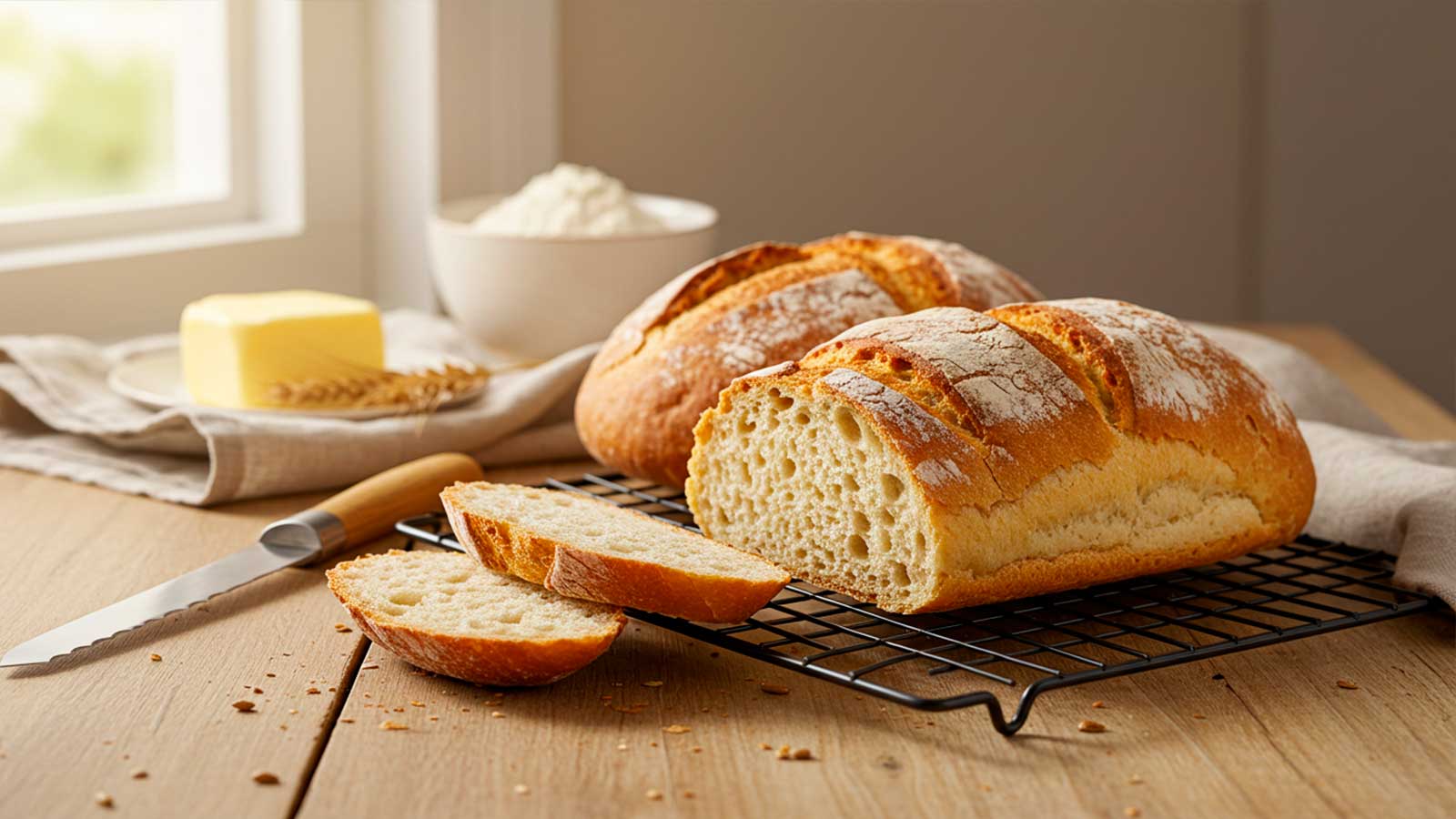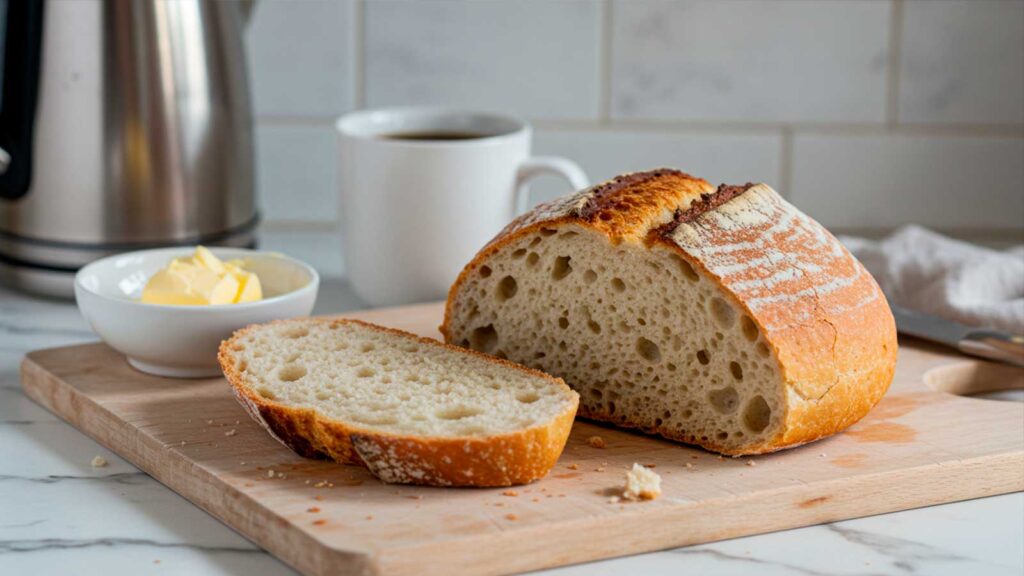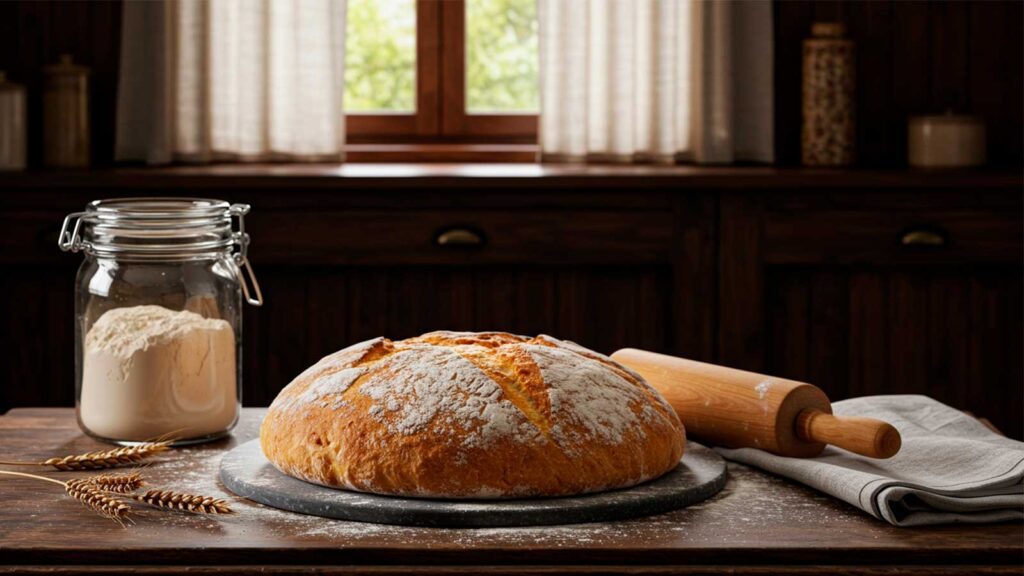If you are looking for a homemade bread recipe that truly works—using affordable ingredients and a straightforward method—you’ve come to the right place. Bread baked at home has an unmistakable flavor and a texture that easily surpasses store-bought loaves. In addition, the experience of kneading the dough, watching the yeast work, and smelling fresh bread coming out of the oven is unique and comforting.
In this article, you’ll learn the step-by-step process of a traditional homemade bread recipe, priceless tips to guarantee perfect results, amazing variations built on the same base, and answers to the most common questions about preparation. Put on your apron and discover how to bake the softest, most flavorful bread you’ve ever tasted!
Traditional homemade bread recipe
Ingredients
- 1 kg (about 8 cups) all-purpose flour
- 600 ml (about 2½ cups) warm water
- 2 tablespoons sugar
- 1 level tablespoon salt
- 30 g fresh baker’s yeast (or 10 g instant dry yeast)
- 2 tablespoons oil (soy, corn, or sunflower)
Method of preparation
Activate the yeast
In a small bowl, combine the fresh (or dry) yeast, sugar, and about 100 ml of the warm water. Stir until completely dissolved. Let it rest for 10 minutes or until a foam forms on the surface. This step confirms that the yeast is alive and ready to work.
Prepare the dry ingredients
In a large mixing bowl, add the sifted flour and salt. Mix them briefly with a wooden spoon or your hands to distribute evenly.
Add the liquids
Make a well in the center of the flour and pour in the oil. Next, add the foamy yeast mixture and gradually pour in the rest of the warm water. Mix with your hands or a sturdy spoon, working from the outside in, until all the flour is incorporated and you have a moist, heavy dough.
Knead the dough
Transfer the dough to a lightly floured surface and begin kneading. Use the heels of your hands to push the dough forward, then fold it back over itself. Repeat for about 10–15 minutes, until the dough is smooth, elastic, and no longer sticks to your hands. Sprinkle only a little more flour if absolutely necessary.
First rise
Form the dough into a ball, place it back in the bowl lightly greased with oil, and cover with a clean, dry cloth. Let it rest in a draft-free, mildly warm spot (such as inside the oven with the light on) for about 1 hour, or until it doubles in size.
Shape the loaves
After rising, turn the dough out onto the counter and divide it into two equal parts with a knife or dough scraper. Shape each piece as desired: sandwich loaf, round boule, braid, or even small rolls.
Second rise
Place the shaped loaves in greased pans or on trays lined with parchment paper. Cover again with a cloth and let them rise for another 30–40 minutes. This second proof yields lighter, airier bread.
Bake the bread
Preheat the oven to 180 °C / 350 °F at least 10 minutes in advance. Bake the loaves for 35–40 minutes, or until they are golden on top and sound hollow when tapped on the bottom.
Cool before serving
Remove the bread from the oven and carefully take it out of the pans. Let it cool on a rack or clean cloth before slicing. This prevents the crumb from becoming gummy.

Golden tips for perfect homemade bread
Making an excellent homemade bread recipe takes more than following a list of ingredients. Success lies in the details—small care points that often go unnoticed. Below are valuable tips that make all the difference, whether you’re a beginner or a seasoned baker.
Don’t use hot water
One of the most common reasons a homemade bread recipe fails is incorrect water temperature. If the water is too hot, it can kill the yeast before it activates. Aim for warm water—about 36 °C to 40 °C (97 °F to 104 °F)—roughly the temperature of a comfortable bath. This allows the yeast to develop properly and helps the bread rise as expected.
Beware of excess flour
During kneading, the dough usually sticks to your hands at first. That’s normal. Many people add too much flour to make it easier to handle, which can leave the bread heavy and dry. An ideal homemade bread recipe dough should be slightly sticky yet pliable. Dust flour only on the work surface and your hands—avoid adding it directly into the dough.
Knead with patience and care
Kneading is crucial. It’s when the flour’s gluten develops, creating the structure that gives bread its elasticity and lightness. Knead for at least 10–15 minutes, or until you feel the dough become smooth and stretchy. You can use a stand mixer with a dough hook, but hand-kneading adds an artisanal touch to your homemade bread recipe.
Let the dough rise in a warm, draft-free spot
Proper fermentation is vital. After kneading, the dough must rest and rise until doubled. Place it in a lightly greased bowl, cover with a clean cloth, and set it in a draft-free area. Warmth helps yeast act efficiently. A practical tip: leave the dough inside the switched-off oven with the light on—an ideal environment for growth.
Grease pans or use parchment paper
Prevent your bread from sticking to the pan by lightly greasing with oil or butter, or lining with parchment. This makes unmolding easier and promotes a more attractive, even crust—enhancing the professional look of your homemade bread recipe.
Spritz water before baking
A trick used by expert bakers is to spray a little water inside the oven during the first minutes of baking. The steam helps create a thin, crispy crust while keeping the crumb soft. You can also place a small pan of water on the oven floor.
Wait for the bread to cool before slicing
It’s tempting to cut bread while it’s still hot, but wait at least 20 minutes after removing it from the oven. During this time, internal steam finishes setting the crumb structure, preventing a gummy or overly moist texture. Respecting this resting time further elevates your homemade bread recipe.

Variations on the homemade bread recipe
Milk bread
Replace half of the water in the homemade bread recipe with warm milk. The result is a softer, slightly sweeter loaf.
Homemade bread with fine herbs
Add dried herbs such as oregano, rosemary, thyme, or parsley to the dough. It gives an irresistible aroma and pairs perfectly with butter.
Cheese bread
Mix small cubes of semi-hard cheese or Parmesan into the dough when shaping. The cheese melts in the oven and forms delicious crusty pockets.
Sweet homemade bread recipe
Add extra sugar (about 4 tablespoons) to the dough, plus ground cinnamon and raisins. After baking, brush with condensed milk and sprinkle shredded coconut.
Whole-wheat bread
Replace up to 50 % of the white flour with whole-wheat flour. Add a little more water and, if desired, seeds such as flax or sesame.
How to keep your homemade bread fresh longer
Once cool, store the bread in a clean plastic bag or a dry tea towel. Avoid refrigerating—instead, freeze in portions. To serve, thaw at room temperature and warm in the oven for a few minutes.

What to do when the bread doesn’t rise?
This is a common concern when making any homemade bread recipe. Check these main mistakes:
- Expired yeast or yeast killed by hot water
- Insufficient kneading
- Environment too cold for fermentation
- Not enough resting time
If the bread still doesn’t rise, try a different yeast brand or let the dough rest inside the (turned-off) oven with the light on.
Equipment that can help with your homemade bread recipe
- Large plastic or stainless bowl: makes mixing and kneading easier.
- Rolling pin: useful for precise shaping.
- Stand mixer with dough hook (optional): excellent for heavy doughs.
- Loaf pans: ideal for tall, uniform loaves.
- Cooling rack: lets bread cool without moistening the base.
Fun facts about homemade bread
- The practice of baking bread at home grew over 300 % during the pandemic, becoming both a hobby and a source of income.
- In ancient Egypt, bread was used as a form of payment.
- There are more than 500 types of bread worldwide, and most share a base similar to this homemade bread recipe.
Homemade bread recipe FAQ
Can I freeze the bread after baking?
Yes! Once cool, wrap it well and freeze for up to 3 months.
Do I need to brush egg yolk on top?
No, it’s optional. Yolk gives a nice shine, but the bread bakes perfectly without it.
Does homemade bread get hard after a day?
If stored properly, it stays soft for up to 3 days. Warm it gently before serving.
Can I use baking powder instead of yeast?
No. It won’t make the dough rise in the same way. Use only instant or fresh baker’s yeast.
Can I make this recipe without kneading?
Yes, there’s a version called “no-knead bread.” A long fermentation replaces kneading but takes more time.
READ ALSO:
- Learn How to Make Alfajor at Home
- Natural Yogurt: Discover the Benefits and How to Make It at Home
- Vaca Atolada: A Classic of Brazilian Cuisine
- Petit Gâteau Recipe: Learn to Make It at Home
JOIN OUR RECIPE GROUP
WE’RE ON PINTEREST
I hope you enjoyed this homemade bread recipe!